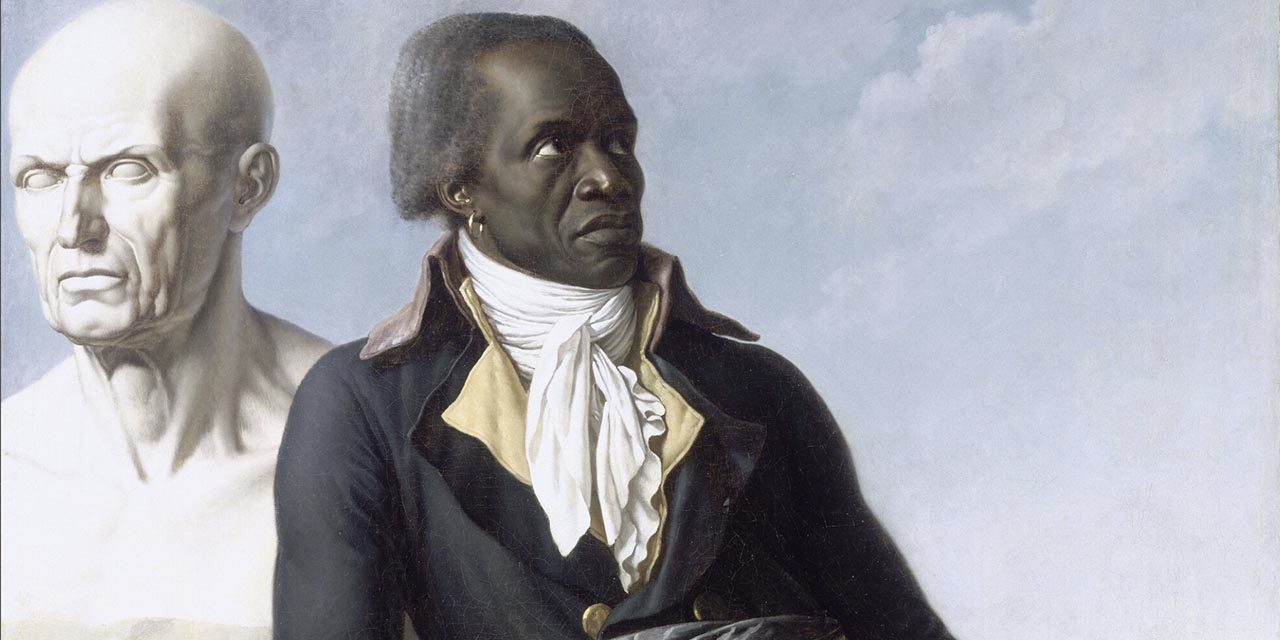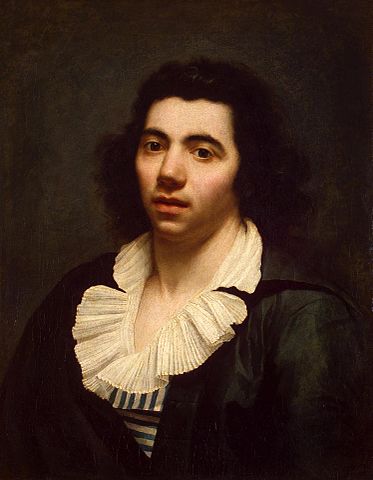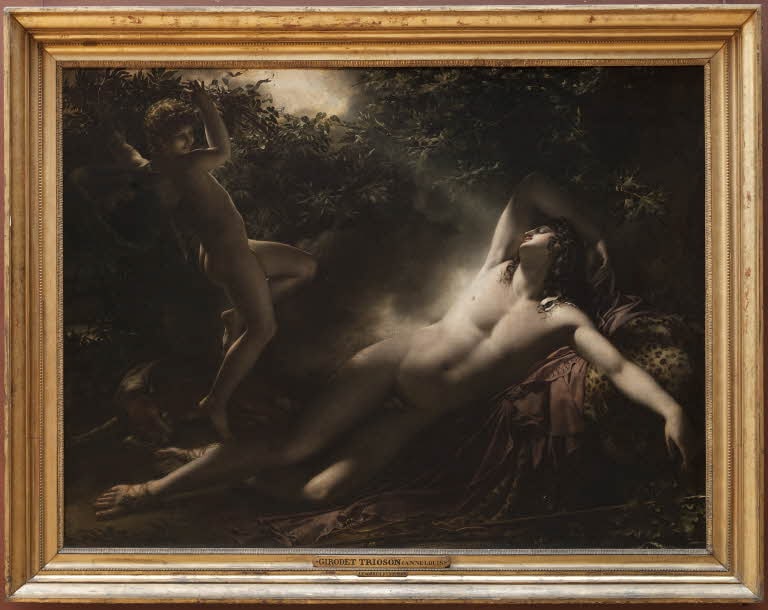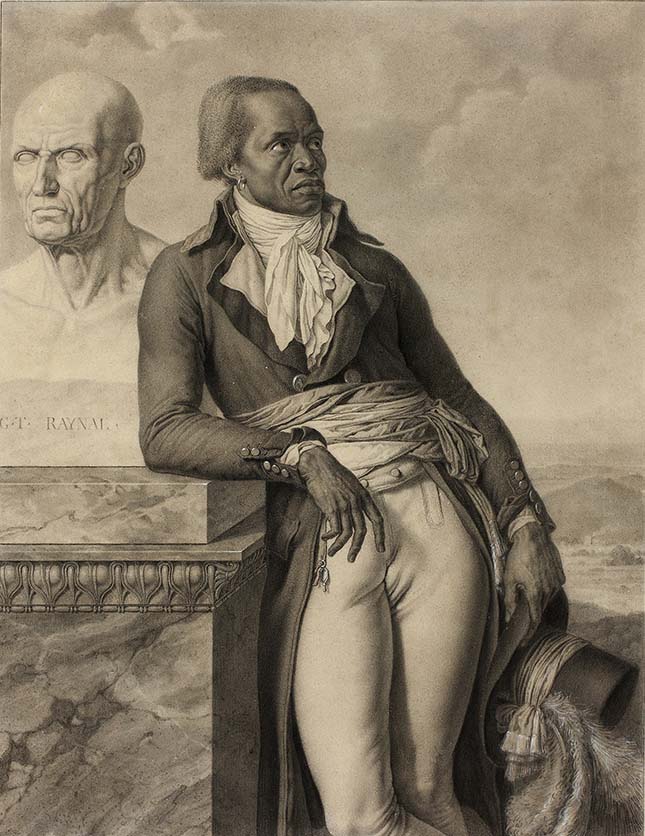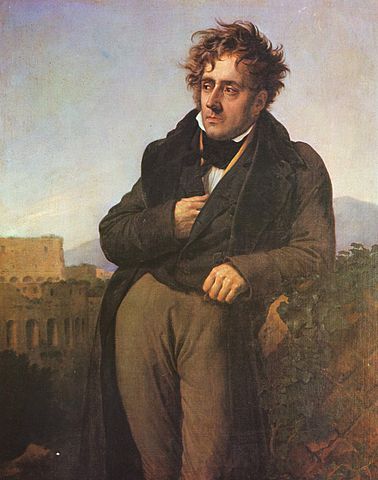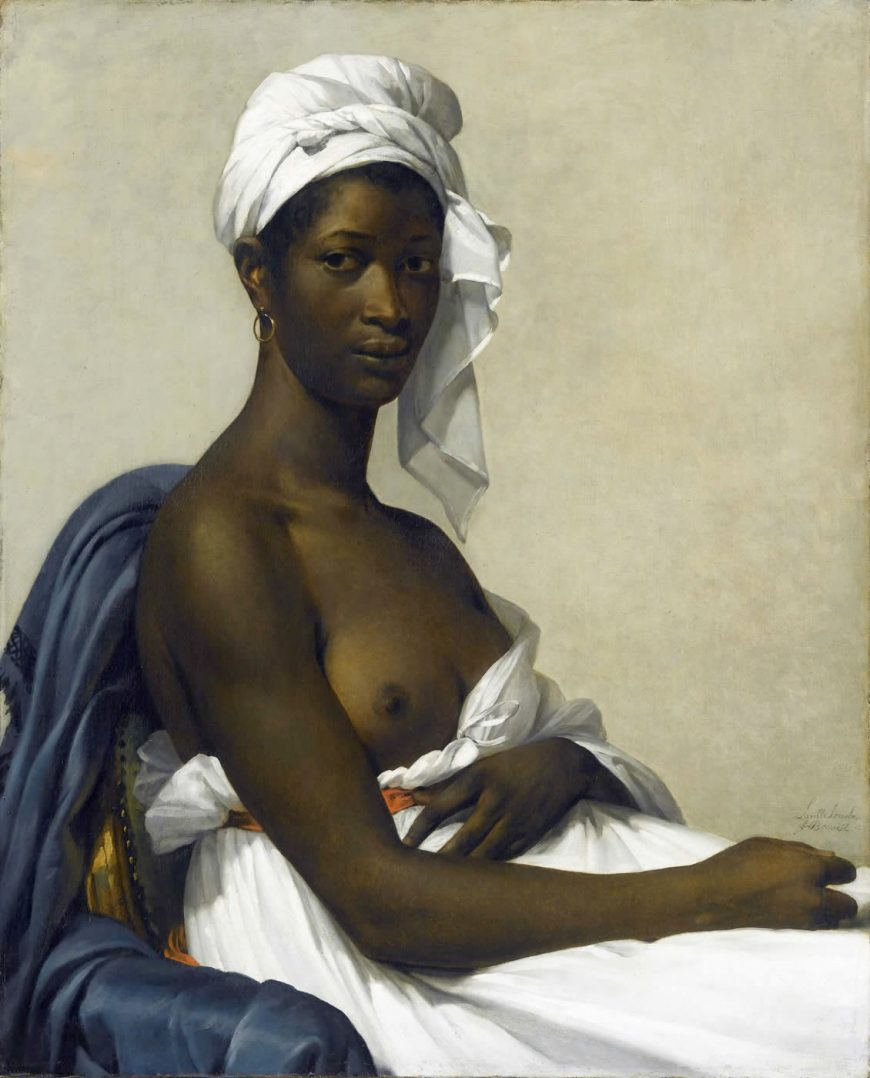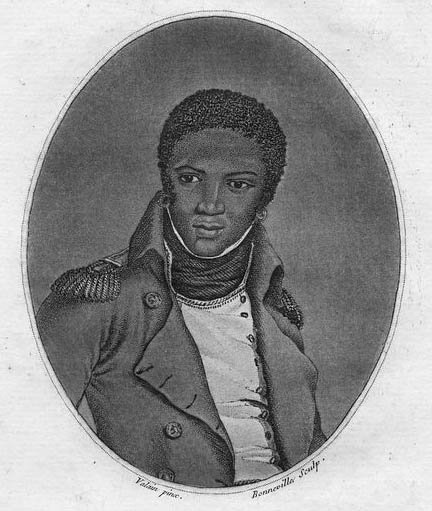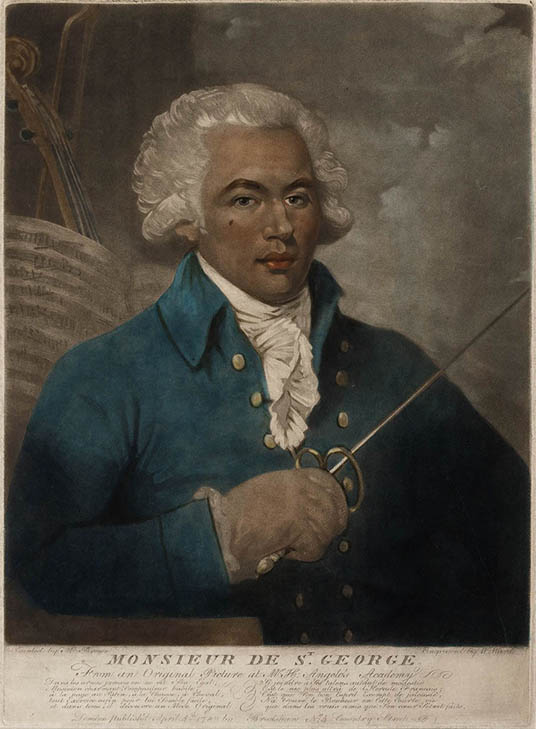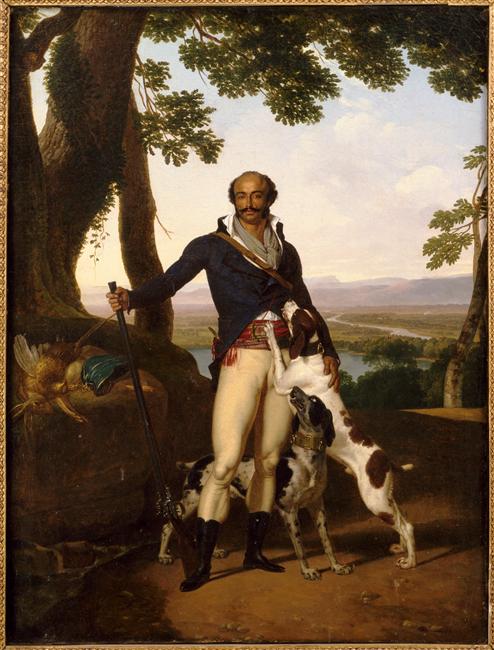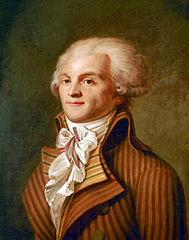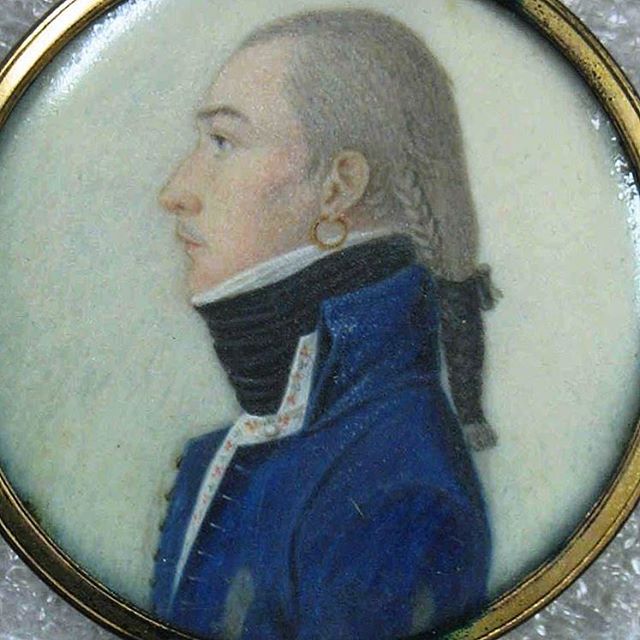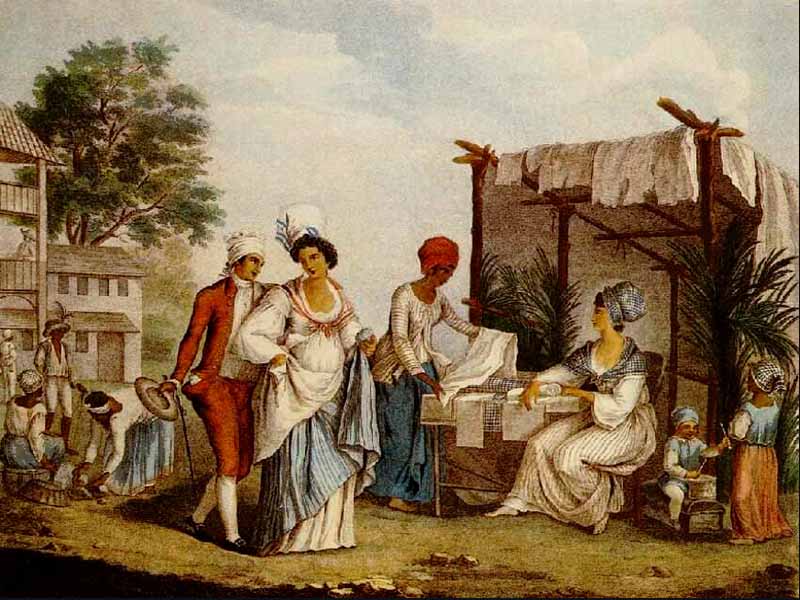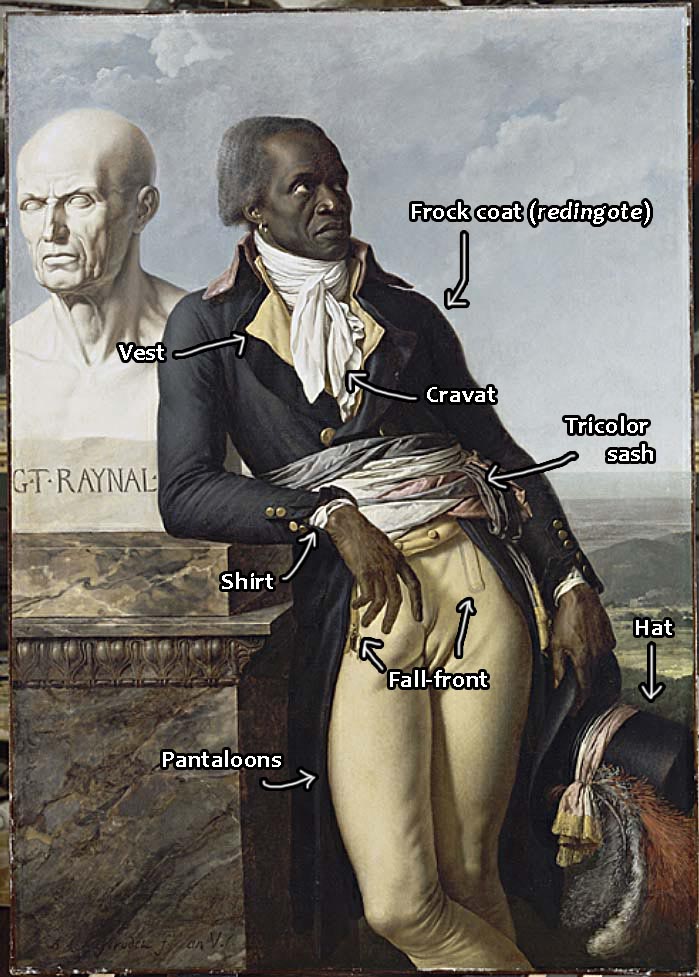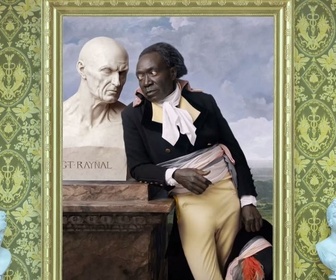This important painting of a Black Haitian deputy, once enslaved, commemorates his participation in the assembly that abolished slavery in France in 1794. He wears the tricolored uniform of a deputy of the French National Convention and only his gold earring speaks to his Colonial ties.
About the Portrait
Anne-Louis Girodet (Fig. 1) painted this powerful portrait of Haitian revolutionary Jean-Baptiste Belley in 1797 during the Directoire period of the French Revolution. Girodet (1767-1824) was a French painter in the Neoclassical and Romantic styles, originally trained in architecture (Brown). He was a Republican and painted scenes of the fall of the Bastille and other events of the Revolution in the 1790s, but became famous initially for his deeply erotic mythological scenes like Endymion (Fig. 2). His career was affected by scandals even as he won prizes for his art, and he eventually gained his most lasting fame from painting portraits of the Bonaparte family (Brown). His appreciation for the male form and the sensuality of his male nudes has led some scholars to suggest that he was gay (Smalls 2).
He was heavily influenced by Jacques-Louis David (1748-1825), whose artistic school he belonged to in the 1780s, but his work is most important as a precursor to and early proponent of the Romantic movement (Brown). It differs from David’s in atmosphere and personality, “introducing mystery, irrationality, and sensuality into the hard, clear, and civic-minded art of David” (Bellenger).
Girodet, an able portraitist, enabled Belley to exude both dignity and sensuality in this image. At least one full preparatory drawing (Fig. 3) was created in advance of the painting, and many more were probably executed beforehand in order to decide on the design. Belley’s casual, almost sultry lean appears in other paintings by the artist and may have been a favorite pose (Fig. 4). This portrait was exhibited at the famed Paris Salon in 1798, where Marie-Guillemine Benoist’s 1800 Portrait of Madeleine (Fig. 5) appeared two years later similarly affirming Black equality and dignity (Gaze 184).
Jean-Baptiste Belley (1746–1805) was a representative of the National Convention in Paris from 1794 and was one of its first three Black deputies (Popkin 327). He had been born in Senegal but was sold into slavery as a small child and taken to Saint-Domingue (now Haiti), a French colony in the Americas (Halliday 107). Belley acquired freedom around 1769 by agreeing to serve in the French army, a common escape route that in some cases only exchanged one kind of servitude for another (Grigsby 25). Despite supporting the emancipation of the enslaved, Belley himself had been a slave owner, and he held a “privileged intermediate position, neither slave nor white” in Saint-Domingue (Grigsby 22). He participated in the assembly of the Convention on February 4th, 1794 that abolished slavery in French territories (though it had already been abolished in Saint-Domingue the previous year; Napoleon revoked the decree eight years later) and this painting was created to commemorate the event (Grigsby 14, Johnson 181, Halliday 107).
While the French government was extremely racially unequal, Belley was far from the only Black man in government: He arrived at the Convention in 1794 with fellow Haitian Jean-Baptiste Mills, and Charles-Guillaume Castaing (who later married Françoise de Beauharnais, sister-in-law to Empress Josephine) joined them from a constituency in France (McCloy 83, Knapton 156). In 1796 lawyer Pierre Pinchinat and brigadier-general Antoine Chanlatte were elected, and in 1797 politician Étienne Mentor earned a seat and served until the end of the legislature in 1799 (Fig. 6) (McCloy 84). Other Black men and women served the Jacobin cause during the French Revolution, from esteemed county administrators to entire army regiments (McCloy 85).
Girodet posed Belley alongside a marble bust depicting the abolitionist Guillaume-Thomas Raynal (1713-1796), who was only a year dead, and may have been based off of a portrait bust exhibited at the 1796 Salon (Halliday 107). The bust, column, and broad landscape all envelop Belley in neoclassical portrait tradition while his uniform declares him a modern man – and the larger-than-life white marble bust behind him suggests a pointed comparison of skin color. The painting has been called a “pictorial meditation on the abolition of black slavery” that “derives power from forceful and startling juxtapositions” (Grigsby 22-23). Scholars believe that Girodet undertook the portrait of his own accord – it was not commissioned by Belley or acquired by him afterward – and it was presented twice to critical acclaim (Halliday 107). We do not know what Belley thought of this portrait and its symbolism, which may have developed without his input.
Fig. 1 - Anne-Louis Girodet (French, 1767-1824). Self-portrait, 1790. Oil on canvas; 59 x 46 cm. St. Petersburg: The State Hermitage Museum, ГЭ-5660. Source: Hermitage
Fig. 2 - Anne-Louis Girodet (French, 1767-1824). Endymion. Effet de lune, 1791. Oil on canvas; 198 x 261 cm (77.9 x 102.7 in). Paris: Louvre, INV. 4935. Source: Louvre
Fig. 3 - Anne-Louis Girodet (French, 1767-1824). Jean-Baptiste Belley, ca. 1797. Black chalk; 36.9 × 30.3 cm. Chicago: Art Institute of Chicago, 1973.156. Source: AIC
Fig. 4 - Anne-Louis Girodet (French, 1767-1824). Portrait of Chateaubriand, after 1808. Oil on canvas; 130 x 96 cm. Saint-Malo: Musée d’Histoire de la Ville et du Pays Malouin, 1950.11.1. Source: Wikimedia Commons
Fig. 5 - Marie-Guillemine Benoist (French, 1768-1826). Portrait d'une femme noire (Madeleine), 1800. Oil on canvas; 81 x 65 cm. Paris: Louvre, INV. 2508. Source: Louvre
Extant fine portraits of Black people from eighteenth-century France are rare but by no means nonexistent. Belley’s portrait can be compared to those of the Chevalier de Saint-Georges (Fig. 7) and General Alexandre Dumas (father to the author of the same name) (Fig. 8), along with a number of portraits of anonymous sitters like this one.
Fig. 6 - François Bonneville (French, active 1787-1802). E. V. Mentor, 1802. New York Public Library, Pre.x.266. Source: NYPL
Fig. 7 - After Mather Brown (American, active England, 1761 – May 25, 1831). Monsieur de St. George, 1788. Mezzotint; 497 mm x 323 mm cm. Royal Museums Greenwich, ZBA2646. Source: RMG
Fig. 8 - Louis Gauffier (French, 1762-1801). Portrait d'un chasseur avec ses chiens dans un paysage, dit Portrait d'Alexandre Dumas père, 1790s. Oil on paper; 32.5 x 25 cm. Bayonne: Musée Bonnat-Helleu, CM539. Source: RMN
Anne-Louis Girodet de Roucy-Triosson (French, 1767–1824). Portrait of Jean-Baptiste Belley, 1797. Oil on canvas; 159 x 111 cm (62.5 x 43.7 in). Versailles: Musée du Château, MV 4616. Source: Ministère de la Culture
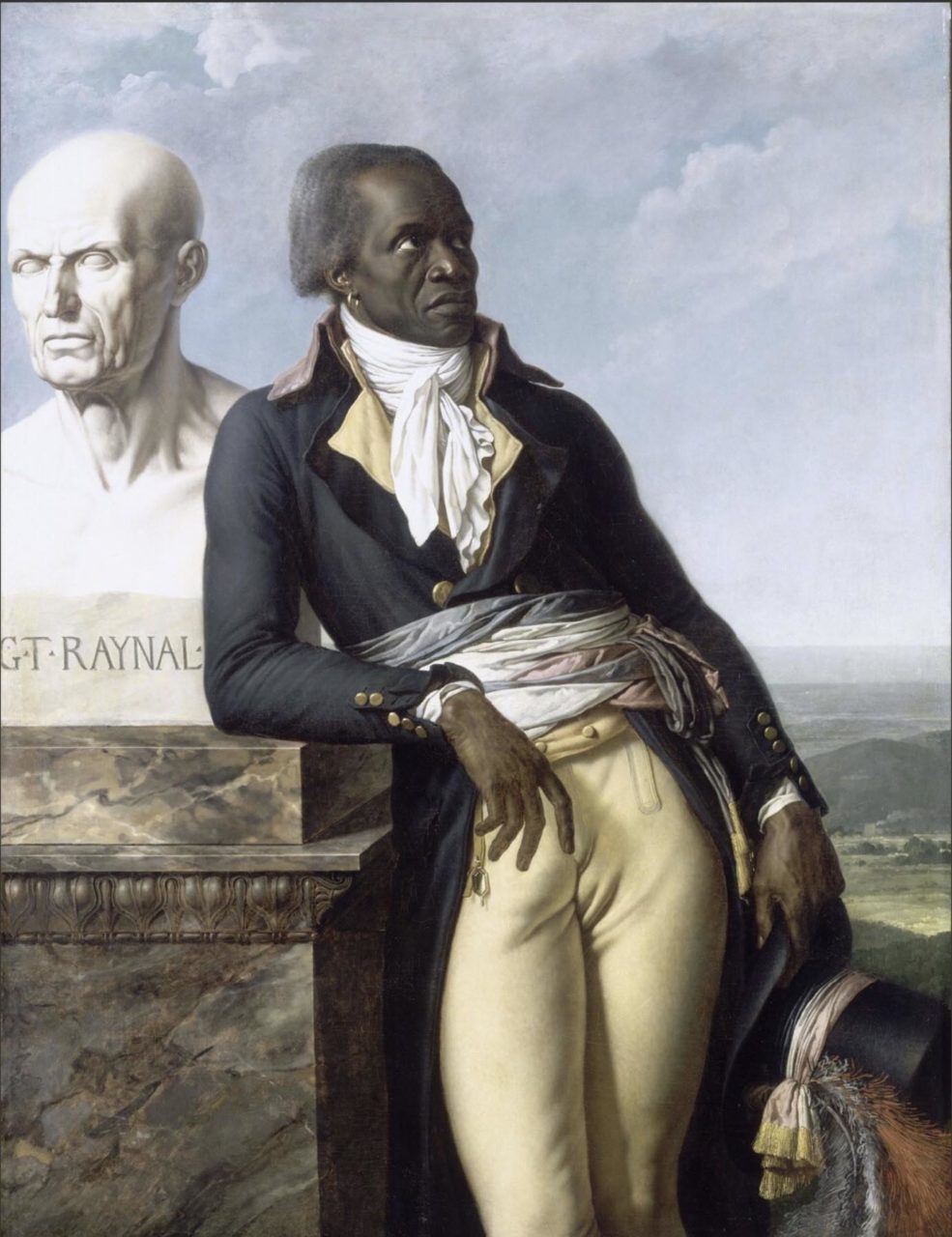
About the Fashion
G iven that Girodet painted this to commemorate Belley’s presence at the Convention as a deputy, it follows that Belley is depicted in his uniform as a representative (AIC). Much the same outfit can be seen on fellow deputy Édouard Milhaud in figure 9, though he wears his coat buttoned up and sash across his chest. The vibrant red collar on the navy coat is more apparent on Milhaud than it appears on Belley. The same color scheme and general costume was worn by soldiers (like the young Napoleon, Fig. 10) and some citizens. While the silhouette follows the lines of fashionable clothing, the 1790s were an era of toeing the line – too fashionable, and one risked being seen as in league with the deposed aristocracy.
The revolutionary government took some of its clothing-related cues from the work of Girodet’s mentor David, who designed uniforms for the new Republic (Fig. 11), as well as from the tri-color banners and cockades that Jacobin supporters rallied under (Harris 285, 299-300). Red and blue were the colors of Paris, and white is said to have been added on request of the Marquis de Lafayette to “show the king’s good will” (Zieseniss 49). As a civil representative of the people, Belley wears full-length pantaloons (pantalons) rather than knee-length breeches, which were a sign of aristocracy (Esguerra).
Fig. 9 - Jean-François Garneray (French, 1755-1837). Édouard Jean Baptiste Milhaud, deputy of the Convention, in his uniform of representant of the People to the Armies, 1793-4. Oil on canvas. Vizille: Musée de la Révolution française, MRF D 1991-14. Source: Wikimedia Commons
Fig. 10 - Antoine Jean Gros (French, 1771-1835). Le general Bonaparte au Pont d'Arcole, 1796-7. Oil on canvas; 130 x 94 cm. Musée national des châteaux de Versailles et de Trianon, MV 6314 ; RF 271. Source: POP
Fig. 11 - Jacques-Louis David (French, 1748-1825). Le représentant du peuple François en fonction, 1794. Source: Library of Congress
Fig. 12 - Designer unknown (French). Bel habit de Cour à la Française ayant appartenu au Maréchal Louis Alexandre Berthier, Prince de Wagram, ca. 1799-1804. Blue silk velvet, gold thread, silver lamé; silk lining. Paris, Lot 314, April 29, 2014. Source: Sotheby's
While David’s idea of a costume unrelated to any other modern clothing and connected to antiquity was an attractive prospect, his designs were in the end mostly ignored (Harvey 128). Only his tri-colored sash, skin-tight leggings, and the idea of the festive hat made it into the outfit that Belley wears. The deputy’s dark blue coat, pale vest, and white cravat are also visible, and he wears a linen shirt underneath for cleanliness (the cuffs are visible at his wrists). Hats, worn by both men and women of all social ranks, were an English vogue; Belley’s tricolored ostrich feathers fit the fashion perfectly (Fig. 9) (Zieseniss 34).
French men’s fashions at the end of the century changed continually, especially for a man in Belley’s position. In the 1780s, the appearance of conspicuous aristocratic luxury was still the goal, with glittering metal-thread embroidery and silks galore (Zieseniss 24). Had Belley been in Paris in 1789 for the meeting of the Estates General, he would have been required to wear a sombre suit all in black (Harvey 126). By the turn of the century, the new leader Napoleon demanded colorful silks and velvets once again for his consuls and court (Fig. 12) (Zieseniss 83).
Some legislators and leaders felt confident enough to retain certain aspects of fashion, including colorful silk waistcoats and buckled wigs (Fig. 13), only to find themselves underneath the guillotine sooner or later (Steele 46). However, most dress changes for men were in color and fabric, not silhouette. The severest differences in dress came with the sans-culottes in 1792, who wore long trousers, red caps and boxy jackets (carmagnoles), and the counter-revolutionary muscadin and incroyable dandies, who were satirized for their silks, odd hairstyles, and bright colors (Fig. 14) (Zieseniss 53).
Belley wears a frock coat (redingote) – which began as a kind of sporting coat decades earlier – in the rather angular habit dégagé style that appeared around 1790 and was eventually adopted by most of the Revolutionary leaders (Leventon 176, Zieseniss 39) (Fig. 15). Tailoring was beginning to gain importance as very fitted looks using shaped wool coats and leather breeches became popular. In The Age of Napoleon: Costume from Revolution to Empire, 1789-1815 (1989), Charles Zieseniss describes:
“Throughout the revolutionary period, with little exception, the masculine costume changed only in detail. The narrow coat… had long straight skirts and a high collar. The vest was made of silk but could also be in kerseymere, red-orange in color, for example, and trimmed with multicolored ribbons. The redingote, or frock coat, similarly cut, but more ample, was still very much in fashion. When double-breasted and cut away very high to show the vest underneath, it was called a habit dégagé or a habit à l’anglaise. Both costumes were buttoned high and worn with tight breeches. The new patriots of France sported clothing of all colors…” (51)
Suits began to lose color during the 1790s, partially in an avoidance of aristocratic excess and partially due to English fashions, which had seeped into mainstream European style from the English countryside several decades beforehand (Steele 35). The Frenchman in figure 16 wears a casual short coat, but his ensemble is in black and dull colors, and he wears riding boots, an affectation of English fashion. Clothing was extremely political during the end of the eighteenth century in France, and many men did their best to distance themselves from symbols of the fallen ancien régime. Even the aristocracy donned English-looking clothing (Fig. 17) (Esguerra).
Belley’s tight fall-front pantaloons, of which similar examples can be seen in figures 8 and 17, are also a very English piece of clothing. Theorist Anne Hollander described this kind of look as “a general legginess,” made up of “high waists, very high crotches, and long, well-articulated legs with big, Classical-looking feet” (225). Tight-fitting pantaloons (long) and breeches (short) were often light-colored, so as to imitate the effect of nudity on white men and bring them closer to the pale, naked marble sculptures of Ancient Greece (Hollander 225). On Belley, of course, such breeches are not skin-colored, and give lie to the so-called ‘equality’ of Republican costume.
The hairstyles favored by patriots in the 1790s tended toward unkempt, chin-length with short bangs (Figs. 9 & 10), but portraits of more prominent men show that the sculpted, powdered styles of the aristocracy did hold on in some ways (Fig. 13). Belley’s hair seems to be styled in a natural version of what Joachim Lebreton wears in figure 18, with no height on top and some length at the sides. While it is possible that the gray in his hair results from powder, Belley was fifty-one at the time of this portrait and it is more likely that his hair was simply going gray. Hair powdering, seen as an aristocratic affectation, had gone out of style amongst the citizenry around 1790 and was only popular amongst incroyables like the young man in figure 14 (Mantin 30).
Lastly, Belley sports a gold hoop earring (possibly one of a pair). While it resembles the one seen on the young incroyable (Fig. 14), it is more likely a fashion from the colony, as Haitians of all colors and statuses were recorded as “piercing one or both ears [and] sporting a gold hoop” during this time, regardless of political leaning (White 41). Residents of European colonies ignored and embraced Continental fashion to various extents (Fig. 19), but portraits of Black Haitian leaders like Toussaint Louverture (Fig. 20), Jean-Jacques Dessalines, and Vincent Ogé show that Belley would have been used to dressing in this style in the course of his work in Saint-Domingue. He cuts a sharp figure in his representative’s uniform, and we can only imagine that his compatriots Jean-Baptiste Mills and Étienne Mentor must have dressed similarly.
Fig. 13 - Artist unknown (French). Portrait of Maximilien Robespierre (1758-1794), ca. 1790. Oil on canvas; 60 x 49 cm. Paris: Musée Carnavalet, P 729. Source: Carnavalet
Fig. 14 - Artist unknown (French). Portrait in Profile of a Young Man, 1790s. Watercolor on ivory; (2 x 2 in). New York: Brooklyn Museum, 25.905. Source: Brooklyn Museum
Fig. 15 - Designer unknown (French). Ensemble, ca. 1790-95. Cotton (jacket). Los Angeles County Museum of Art. Source: LACMA Unframed
Fig. 16 - François Gérard (French, 1770-1837). Jean-Baptiste Isabey, Miniaturist, with his Daughter, 1795. Oil on canvas; 194.5 x 130 cm (76.5 x 51.1 in). Paris: Louvre, INV 4764. Source: Louvre
Fig. 17 - Martin Drolling (French, 1752-1817). Barthélémy Charles, Comte de Dreux-Nancré, 1797. Oil on canvas; 94 x 75 cm (37 x 29.5 in). Private collection. Source: Wikimedia Commons
Fig. 18 - Adélaïde Labille-Guiard (French, 1749-1803). Portrait of Joachim Lebreton, 1795. Oil on canvas; 73 x 59.7 cm (28 3/4 x 23 1/2 in). Kansas City, MO: Nelson-Atkins Museum of Art, 94-34. Source: NAMA
Fig. 19 - Agostino Brunias (Italian (active Haiti), 1728-1796). La marchande de tissu, Saint-Domingue, before 1804. Source: Wikimedia Commons
Fig. 20 - Artist unknown (French). Toussaint Louverture Chef des Noirs Insurgés de Saint Domingue, ca. 1800. Engraving; 29.2 x 20.7 cm. Providence, RI: John Carter Brown Library, 63-149. Source: JCB Luna
Legacy
Girodet’s portrait of Belley has been circulated since its first exhibition in 1797 and has henceforth captured the imaginations of many. Senegalese artist Omar Victor Diop recreated the painting as part of his famous project Diaspora (2014), meant to “show the duality of living a life of glory and recognition, while facing the challenges of being ‘other'” (Wilson) (Fig. 21).
Artist Alexis Esquivel co-opted the famous image in 2018 (Fig. 22) in order to bring to light a contemporary man: Free Black Cuban Jose Antonio Aponte, who fought in the American Revolutionary War and was murdered by Spanish authorities in 1812 on the charge of fomenting rebellion (Bernstein).
Most recently, actor Denis Tadie Tuene played Belley in the second season (episode 3) of the French sketch series A Musée vous, à musée moi, where he talked to Raynal (played by Alain Bouzigues) in a dream (Fig. 23).
Fig. 21 - Omar Victor Diop (Senegalese, 1980-present). Diaspora: Jean-Baptiste Belley, 2014. Photograph. Source: OVD Photographer
Fig. 22 - Alexis Esquivel (Cuban). Como fuego arde en vivas llamas (Like fire burns in living flames), 2018. Acrylic on canvas. Source: Burnaway Art Review
Fig. 23 - Denis Tadie Tuene & Alain Bouzigues Pablo Muñoz Gomez (French). A Musée vous, à musée moi: Jean-Baptiste Belley, I have a French dream, 2019. Video. Source: Replay
References:
- AIC. “Jean-Baptiste Belley.” The Collection, The Art Institute of Chicago. Accessed 26 August 2020. https://www.artic.edu/artworks/44272/jean-baptiste-belley
- Bellenger, Sylvain, et al. “Girodet: Romantic Rebel.” The Art Institute of Chicago, 2006. Accessed 26 August 2020. https://archive.artic.edu/girodet/themes.html
- Bernstein, Jennifer R. “Aponte Forever: “Art and Black Freedom” in Nashville.” Burnaway Art Review, 24 January 2020. Accessed 31 August 2020. https://burnaway.org/visionary-aponte-nashville/
- Brown, Stephanie Nevison. “Girodet (de Roussy-Trioson) [Girodet-Trioson], Anne-Louis.” Grove Art Online.
2003; Accessed 26 Aug. 2020. Oxford Art Online - Esguerra, Clarissa M. “French Revolutionary Fashion.” LACMA Unframed, The Los Angeles County Museum of Art, 3 August 2016. Accessed 29 August 2020. https://unframed.lacma.org/2016/08/03/french-revolutionary-fashion
- Gaze, Delia. Concise Dictionary of Women Artists. Hoboken: Taylor and Francis, 2013. http://www.worldcat.org/oclc/831119257
- Grigsby, Darcy Grimaldo. Extremities: Painting Empire in Post-Revolutionary France. New Haven: Yale University Press, 2002. http://www.worldcat.org/oclc/50572575
- Halliday, Tony. Facing the Public: Portraiture in the Aftermath of the French Revolution. Manchester: Manchester University Press, 2000. http://www.worldcat.org/oclc/42049267
- Hollander, Anne. Seeing Through Clothes. Berkeley: University of California Press, 1993. http://www.worldcat.org/oclc/890241112
- Johnson, Erica R. Philanthropy and Race in the Haitian Revolution. Cham: Palgrave Macmillian, 2018. http://www.worldcat.org/oclc/1105448279
- Knapton, Ernest John. Empress Josephine. New York: Harvard UP, 1963. https://penelope.uchicago.edu/Thayer/E/Gazetteer/People/Josephine/KNAEJO/11*.html
- Leventon, Melissa. What People Wore When: A Complete Illustrated History of Costume from Ancient Times to the Nineteenth Century for Every Level of Society. London: Ivy Press, 2017. http://www.worldcat.org/oclc/1107323534
- Mantin, Peter. The French Revolution. Oxford: Heinemann, 1992. http://www.worldcat.org/oclc/837588746
- McCloy, Shelby T. The Negro in France. Lexington: University of Kentucky Press, 1961. http://www.worldcat.org/oclc/401606
- Popkin, Jeremy D. You Are All Free: The Haitian Revolution and the Abolition of Slavery. Cambridge: Cambridge University Press, 2010. http://www.worldcat.org/oclc/701609979
- Smalls, James. “Girodet-Trioson, Anne-Louis (1767-1824).” GLBTQ Archives, 2002. Accessed 29 August 2020. http://www.glbtqarchive.com/arts/girodet_trioson_al_A.pdf
- Steele, Valerie. Paris Fashion: A Cultural History. New York: Bloomsbury, 2017. http://www.worldcat.org/oclc/1060872502
- White, Ashli. Encountering Revolution: Haiti and the Making of the Early Republic. Baltimore: Johns Hopkins University Press, 2010. http://www.worldcat.org/oclc/876646434
- Wilson, Raquel. “Diaspora.” Omar Victor Diop, 2014. Accessed 31 August 2020. https://www.omarviktor.com/project-diaspora
- Zieseniss, Charles-Otto. The Age of Napoleon: Costume from Revolution to Empire, 1789-1815. Metropolitan Museum of Art: Distributed by H. N. Abrams, 1989. http://www.worldcat.org/oclc/797002750

